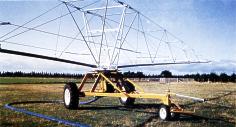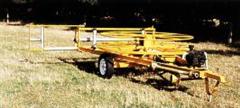

Here is a 250 model Roto-rainer hose trailer that is used to move the Roto-rainer.
A Roto-rainer is a type of irrigation method to spread water by rotating around to irrigate paddocks and farmland.
The name Roto-rainer gives an indication of what it does, roto meaning to rotate around and rainer meaning when it shoots out water it looks like rain.
Positives
- The K-Line and long line need to be moved frequently so compared to them the Roto-rainer is not too time consuming.
- The Roto-rainer can run in any chosen direction.
- The Roto-rainer is not that complicated to run.
- The Roto-rainer is quite cheap and covers a big area of farm land.
Negatives
- They put too much water on a small area unlike other irrigators.
- The Roto-rainer is not very good at irrigating tall crops, but they are good for medium height crops and pasture.
- The Roto-rainer can get damaged in strong winds and they can stall or slow their rotations. This can cause big puddles to emerge on your land.
- The hose can get damaged by getting pulled across hard ground and often needs to be replaced every 7-10 years (at a cost of $10,000).
- Some soils can not use the amount of water that the Roto-rainer puts on.
- Roto-rainers sometimes require two people to move them depending on the model and the amount of gates or trees you need to navigate.
- They take anywhere from half an hour to an hour to shift, depending on how far you are moving it.
- Unlike a hard hose gun the Roto-rainer does not wind up its hose, so before you move it you need to use the special hose trailer and PTO shaft to wind the hose up.
- Roto-rainers can be affected by rolling hills.
Facts
- Land that is flat and has shelter is a good place for the Roto-rainer to work.
- The Roto-rainer has a boom which is the piece that spreads the water around.
- The nozzles at the ends of the boom are called Drive nozzles. These push the water out behind the boom and the pressure of the water getting pushed out, drives the boom around in a rotating circle. As the boom rotates in a circle it starts a mechanical winch (at the other end of the paddock), which moves the Roto-rainer across the paddock so it can complete its irrigation run.(It has a stopper that stops it and it controls itself.)
- Along the boom there are lots of nozzles that shoot out the water while the Roto-rainer rotates.
- You will find that the Roto-rainer is now mostly used for dairy farming, but in the 80's and 90's a lot of cropping farmers used the Roto-rainer. As there are now better irrigators on the market the cropping farmers are now using them.
- The Roto-rainer is rated 3rd best irrigator, as the centre pivot is first and hard hose guns are 2nd.
- The hose is called an Angus hose which is a soft and flexible hose. Water travels through this hose up to the 'boom' where it then gets squirted out onto the paddock via a series of nozzles along the 'boom'.
- Throughout our unit we did not find any one in Duntroon with a Roto-rainer as no farmers here are using them. They are mostly found in other places.
© 2007 – Page created by: Helena, Mikayla and Kassey.


